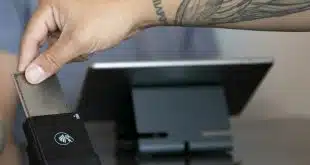Adoption and usage rates for the mobile wallets from Apple Inc., Alphabet Inc. (Google), and Samsung Electronics Co. Ltd. have been far from stellar, but now evidence is emerging that Apple’s decision a year ago to ditch fingerprint identification on its newest smart phones in favor of facial-recognition technology could be making it even harder for Apple Pay to win mass consumer acceptance.
The problem appears to be most acute in physical-store settings, where critics say the process required on the new iPhones to get to the wallet and unlock payment is now more cumbersome with Face ID, Apple’s new authentication technology. Indeed, some say the technology falls short all too often.
“Even if we disregard the pitfalls of the clicks and the pain of the notoriously routinely failing Face ID, a user used to momentarily holding their thumb on the home button to confirm a payment will find this [new process] monumentally more complicated,” notes Duena Blomstrom, an iPhone user and chief executive of PeopleNotTech Ltd., a London-based consulting firm. Her critique appeared in early December as a post on Forbes’s online forum.
The extent to which problems with Face ID may have hurt Apple Pay is unknown. Apple did not respond to an inquiry from Digital Transactions. The technology was introduced with the iPhone X in September 2017 and then incorporated in the iPhone XR, XS, and XS Max, launched this past fall. Unlike rival Android phones, which have added facial-recognition technology but kept fingerprint recognition, the new Apple models replaced Touch ID, the company’s fingerprint technology, with Face ID.
That move, say some observers, could be problematic at busy in-store checkouts, since users must fall back to entering a password if Face ID fails.
“Based on what I’ve seen, Face ID has been an issue for some users since it was introduced. It could be a problem; it certainly doesn’t help,” says Aaron McPherson, vice president for research operations at Mercator Advisory Group, a Maynard, Mass.-based consultancy.
For long-time iPhone users, McPherson says, Face ID also suffers by comparison with Touch ID, which he contends was easier to use because the process was more intuitive. Still, he argues Apple Pay’s less-than-stellar adoption can’t be blamed solely on Face ID.
Mercator’s 2018 survey data indicates a strong consumer preference for either fingerprint recognition or passwords when making mobile payments, compared to facial recognition, though some of this effect could result from the relatively new availability of facial-recognition technology. Since reaching a “high-water mark” at 30% in 2016, usage of “universal” mobile-payments services like Apple Pay and Google Pay among smart-phone-owning adults has declined to 23%, Mercator says. Apple Pay specifically has seen a drop from 14% to 10%.
Experts will caution that correlation is not causation, but other data indicates consumers are struggling to some extent with Face ID and similar technology. In a consumer survey concerned with in-store mobile payments, New York City-based financial-services consultancy Auriemma Consulting Group found those who have facial recognition on their phones were more likely than those who don’t to experience a problem at the point of sale. The difference was 47% compared to 29%.
Those with facial recognition also were more likely than those without to say the problem was related to the phone they were using, 28% to 17%. The survey data included Google Pay and Samsung Pay users as well as Apple Pay users.
“Based on the responses we got on in-store experience, [facial recognition] has definitely been a deterrent,” says Jaclyn Holmes, director of Auriemma’s payments-insights practice. Adds McPherson: “The last thing you need now is to make [mobile payment] more difficult.”
The question now, Holmes says, is whether consumers will simply bypass mobile payments and move from existing plastic cards to contactless cards as these cards become increasingly available. In her post about Apple Pay, Blomstrom expresses little doubt.
“[T]here is no instance where simply strapping a contactless card to the back of your phone doesn’t make the experience more enjoyable than using Apple Pay,” she writes.




